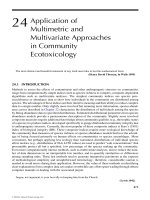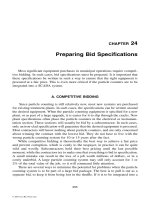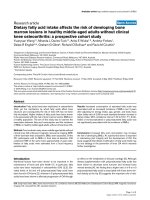Chapter 24 fatty acid catabolism
Bạn đang xem bản rút gọn của tài liệu. Xem và tải ngay bản đầy đủ của tài liệu tại đây (2.28 MB, 46 trang )
Chapter 24
Fatty Acid
Catabolism
Outline
• 24.1 Mobilization of Fats from Dietary
Intake and Adipose Tissue
• 24.2 Beta-Oxidation of Fatty Acids
• 24.3 Odd-Carbon Fatty Acids
• 24.4 Unsaturated Fatty Acids
• 24.5 Other Aspects of Fatty Acid Oxidation
• 24.6 Ketone Bodies
Why Fatty Acids?
(For energy storage?)
• Two reasons:
– The carbon in fatty acids (mostly CH2) is
almost completely reduced (so its
oxidation yields the most energy possible).
– Fatty acids are not hydrated (as monoand polysaccharides are), so they can pack
more closely in storage tissues
Fat from Diet & Adipose Cells
Triacylglycerols either way
• Triglycerides represent the major energy
input in the modern American diet
(but it wasn't always this way)
• Triglycerides are also the major form of
stored energy in the body
• See Table 24.1
• Hormones (glucagon, epinephrine, ACTH)
trigger the release of fatty acids from
adipose tissue
Figure 24.1 · Scanning electron micrograph of an
adipose cell (fat cell)
Globules of triacylglycerols occupy most of the volume
of such cells.
Figure
24.2 ·
Liberation
of fatty
acids from
triacylglycerols in
adipose
tissue is
hormonedependent
Figure 24.3 ·
(a) A duct at the
junction of the
pancreas and
duodenum secretes
pancreatic juice into
the duodenum, the
first portion of the
small intestine.
(b) Hydrolysis of
triacylglycerols by
pancreatic and
intestinal lipases.
Pancreatic lipases
cleave fatty acids at
the C-1 and C-3
positions. Resulting
monoacylglycerols
with fatty acids at C-2
are hydrolyzed by
intestinal lipases.
Fatty acids and
monoacylglycerols are
absorbed through the
intestinal wall and
assembled into
lipoprotein aggregates
termed chylomicrons
• Figure 24.4 · In the small intestine, fatty acids combine with bile
salts in mixed micelles, which deliver fatty acids to epithelial cells
that cover the intestinal villi.
• Triacylglycerols are formed within the epithelial cells.
Beta Oxidation of Fatty Acids
Knoop showed that fatty acids must be
degraded by removal of 2-C units
• Albert Lehninger showed that this occurred
in the mitochondria
• F. Lynen and E. Reichart showed that the 2C unit released is acetyl-CoA, not free
acetate
• The process begins with oxidation of the
carbon that is "beta" to the carboxyl carbon,
so the process is called"beta-oxidation"
Figure 24.5
The oxidative
breakdown of
phenyl fatty acids
observed by
Franz Knoop.
• He observed that
fatty acid analogs
with even
numbers of
carbon atoms
yielded phenyl
acetate, whereas
compounds with
odd numbers of
carbon atoms
produced only
benzoate
Figure 24.6 · Fatty acids are degraded by repeated
cycles of oxidation at the b-carbon and cleavage of the
Ca¾Cb bond to yield acetate units
CoA activates FAs for oxidation
Acyl-CoA synthetase condenses fatty acids
with CoA, with simultaneous hydrolysis of
ATP to AMP and PPi
• Formation of a CoA ester is expensive
energetically
• Reaction just barely breaks even with ATP
hydrolysis
• But subsequent hydrolysis of PPi drives the
reaction strongly forward
• Note the acyl-adenylate intermediate in the
mechanism!
Figure 24.7 · The acyl-CoA
synthetase reaction activates fatty
acids for b-oxidation.
The reaction is driven by hydrolysis of ATP
to AMP and pyrophosphate and by the
subsequent hydrolysis of pyrophosphate
Figure 24.8 ·
The mechanism
of the acyl-CoA
synthetase
reaction
involves fatty
acid carboxylate
attack on ATP to
form an acyladenylate
intermediate.
The fatty acyl
CoA thioester
product is
formed by CoA
attack on this
intermediate
Carnitine as a Carrier
Carnitine carries fatty acyl groups across the
inner mitochondrial membrane
• Short chain fatty acids are carried directly into
the mitochondrial matrix
• Long-chain fatty acids cannot be directly
transported into the matrix
• Long-chain FAs are converted to acyl
carnitines and are then transported in the cell
• Acyl-CoA esters are formed inside the inner
membrane in this way
Figure 24.9
The formation of
acylcarnitines
and their
transport across
the inner
mitochondrial
membrane.
The process
involves the
coordinated
actions of
carnitine
acyltransferases
on both sides of
the membrane
and of a
translocase that
shuttles Oacylcarnitines
across the
membrane
b-Oxidation of Fatty Acids
•
•
•
•
A Repeated Sequence of 4 Reactions
Strategy: create a carbonyl group on the
b-C
First 3 reactions do that; fourth cleaves
the "b-keto ester" in a reverse Claisen
condensation
Products: an acetyl-CoA and a fatty acid
two carbons shorter
The first three reactions are crucial and
classic - we will see them again and again
in other pathways
Figure 24.10
The b-oxidation of
saturated fatty
acids involves a
cycle of four
enzyme-catalyzed
reactions.
Each cycle
produces single
molecules of
FADH2, NADH, and
acetyl-CoA and
yields a fatty acid
shortened by two
carbons.
(The delta [D]
symbol connotes a
double bond, and
its superscript
indicates the
lower-numbered
carbon involved.)
Acyl-CoA Dehydrogenase
Oxidation of the C-Cb bond
• A family of three soluble matrix enzymes
• Mechanism involves proton abstraction,
followed by double bond formation and
hydride removal by FAD
• Electrons are passed to an electron
transfer flavoprotein, and then to the
electron transport chain
• Enzyme is inhibited by a metabolite of
hypoglycin (from akee fruit)
Enoyl-CoA Hydratase
Adds water across the double bond
• at least three forms of the enzyme
are known
• aka crotonases
• Normal reaction converts transenoyl-CoA to L-b-hydroxyacyl-CoA
Hydroxyacyl-CoA
Dehydrogenase
Oxidizes the b-Hydroxyl Group
• This enzyme is completely specific for Lhydroxyacyl-CoA
• D-hydroxylacyl-isomers are handled
differently









